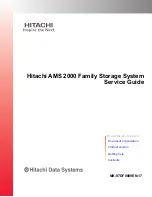
Setting Up RAID Arrays
5-8
Express5800/
ftServer
: System Administrator’s Guide for the Linux Operating System
Example 5-1. Checking the Current State of the Internal Storage Subsystem
#
cat /proc/scsi/scsi
Attached devices:
Host: scsi0 Channel: 00 Id: 00 Lun: 00
Vendor: ATA Model: ST380013AS Rev: 3.00
Type: Direct-Access ANSI SCSI revision: 05
Host: scsi4 Channel: 00 Id: 00 Lun: 00
Vendor: ATA Model: ST380013AS Rev: 3.00
Type: Direct-Access ANSI SCSI revision: 05
Storage Device Definition
The Linux operating system automatically creates device nodes for all devices in a
system.
Miscellaneous SCSI devices such as scanners are generally mapped as /dev/sg*
devices. Note that the Linux operating system also allows some non-SCSI devices to
be addressable as SCSI pseudo-devices. This can be useful to allow certain SCSI
software packages to work with non-SCSI devices.
Setting Up RAID Arrays
This section discusses the following topics:
•
‘‘
RAID Array Overview
”
•
‘‘
Creating a RAID-1 Array
”
•
‘‘
Creating a RAID-0 Array
”
•
‘‘
Creating and Mounting a File System
”
•
‘‘
Checking the Current State of RAID
”
RAID Array Overview
RAID is the basis for fault-tolerant file system availability. As disks come in and go out
of service, the only way to keep the file system available is to mirror it on multiple disks
with a disk in each CPU-I/O enclosure.
All of the file systems are created on RAID devices.
The system supports RAID-1 (mirrored) and RAID-0 (striped) on RAID-1. RAID-0 is
configured using RAID-1 devices, since the underlying devices must be fault tolerant.
Each RAID array has a number (for example,
/dev/md23
) that must be unique among
the running RAID arrays. The RAID array numbers are in the range 0 through 128.
















































